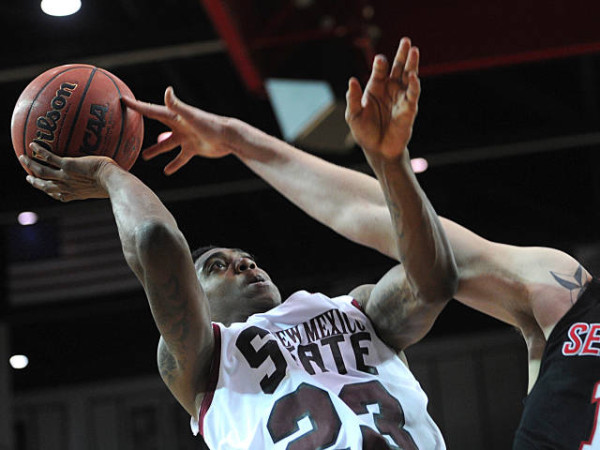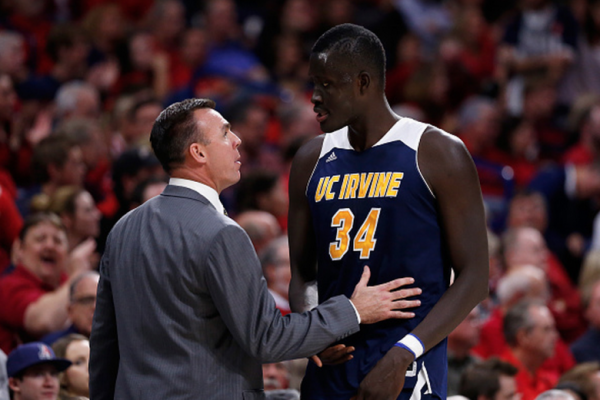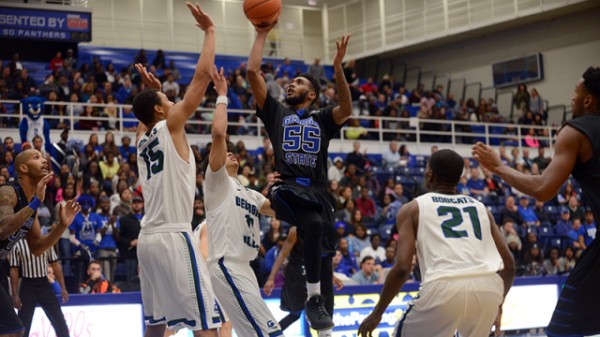Bracket Prep: New Mexico State, UC Irvine & Georgia State
Posted by Tommy Lemoine on March 16th, 2015Let’s finish off the Bracket Prep series with our reviews of each of the weekend mid-major automatic qualifiers to help you fill out your bracket. Here’s a primer on each of the most recent bid winners. The entire series can be found here.
New Mexico State
- WAC Champion (23-10, 13-1)
- RPI/Pomeroy/Sagarin = #103/#88/#106
- Adjusted Scoring Margin = +6.5
- NCAA Seed: #15
Strength: The Aggies are not your average low-seeded mid-major. They have great size – 32nd nationally in effective height – and good athleticism that should allow them to match up with Kansas, at least physically. With four regular contributors standing between 6’8” and 6’10” and an athletic point guard to boot, New Mexico State likes to attack the paint and pound the offensive glass (ninth-best offensive rebounding rate in college hoops). The vast majority of its points come near the basket or at the free throw line, while big men Pascal Siakam (7.7 RPG) and Tshilidzi Nephawe (7.6 RPG) rank among the top 75 offensive rebounders in the country. Defensively, they often apply pressure – both in the full-court and half-court – and do an excellent job of limiting three-point looks; opponents shoot just 29.5 percent from behind the arc, the seventh-best mark in America.
Weakness: New Mexico State was the most-turnover prone team in the WAC and among the worst in the entire country, ranking 326th in offensive turnover rate. Lowly Chicago State (8-24) – whose one strong-suit is causing turnovers – forced the Aggies to cough it up 43 times over the course of two near-upsets during conference play.
Key player: Daniel Mullings (12.6 PPG, 5.0 RPG). The Canadian guard missed 12 games in the middle of the season, and since he’s returned New Mexico State has not lost – 13 straight wins to end the season. Mullings’ athleticism enables him to get into the lane and draw fouls (6.3 fouls drawn per 40 minutes), and there are few perimeter defenders as quick-handed as the senior; his steal rate ranks 11th-best in the country.
Outlook: The #13-seeded Aggies took San Diego State to overtime in the round of 64 last season, and despite getting a #15 seed this time around, they could cause trouble for the Jayhawks. If they can take care of the ball, the WAC champs’ size and length should allow them to match up physically and hang around with their higher-seeded foe.
UC Irvine
- Big West Champion (21-12, 11-5)
- RPI/Pomeroy/Sagarin = #88/#95/#97
- Adjusted Scoring Margin = +3.0
- NCAA Seed: #13
Strength: The Anteaters are a stingy defensive unit – especially on the interior – and since 7’6” center Mamadou Ndiaye returned from injury on February 26, they’ve surrendered more than one point per possession just once. He, along with senior Will Davis II (12.9 PPG, 7RPG), leads a massive frontcourt that held opponents to 42.3 percent two-point shooting this season, by far the best mark in the Big West. Ndiaye, the tallest player in college basketball, is simply unstoppable when he catches the ball near the basket. The team’s three-point shooting (38.3% 3FG) has also significantly improved despite guard Luke Nelson’s (28% 3FG) regression from long distance.
Weakness: UC Irvine does not attack the lane and draw fouls at a very high rate. In fact, its 0.31 free throw attempt per field goal attempt ranks 320th nationally, and just 17.3 percent of the team’s scoring is derived from the charity stripe. When outside shots don’t fall, the bulk of the scoring load falls on the frontcourt. Also, for a team with as much size as the Anteaters, they don’t generate a ton of offensive rebounds (29.8% OReb).
Key player: Mamadou Ndiaye (10.4 PPG, 5.1 RPG). Ndiaye shot 10-of-15 from the field and blocked six shots over UC Irvine’s final two games of the Big West Tournament. He is a game-changer, and there is no other way to put it. Even when the sophomore isn’t blocking shots, he’s often altering them, or deterring opponents from entering the lane altogether.
Outlook: UC Irvine heads to the NCAA Tournament for the first time in school history and should be a tough out once it gets there. The Anteaters are solid on both sides of the ball and boast the seventh-tallest frontcourt in the entire country, key against a Louisville front line that is more limited. Now that Ndiaye and guard Alex Young (9.6 PPG, 3.6 APG) are fully healthy, look for Russell Turner’s bunch to stay competitive for 40 minutes in the round of 64.
Georgia State
- Sun Belt Champion (23-9, 15-5)
- RPI/Pomeroy/Sagarin = #61/#71/#79
- Adjusted Scoring Margin = +7.8
- Likely NCAA Seed: #14
Strength: The Panthers have a high-major backcourt in R.J. Hunter (20.1 PPG) and Ryan Harrow (19.4 PPG), two tremendous offensive creators who are capable of going off for 30+ points on any given night. Louisville transfer Kevin Ware (7.3 PPG) further bolsters the team’s excellent guard play. Georgia State has also been much improved on the defensive end this season, using match-up 2-3 and 1-3-1 zone looks to limit opponents to 0.99 points per possession and force turnovers at the 17th-highest rate in college hoops. In the Sun Belt championship game, the Panthers held Georgia Southern to 36 points on 47 possessions (0.77 PPP) and allowed zero scorers to reach double figures.
Weakness: R.J. Hunter, son of head coach Ron Hunter, has been less accurate from three-point range this season (30% 3FG, down from 40% 3FG) and the team as a whole shoots six percentage points worse from behind the arc. With sharpshooter Manny Atkins now graduated, the lion’s share of the scoring falls on Hunter and Harrow’s shoulders – which is a problem if one of them is limited, like Harrow was on Sunday (hamstring). Additionally, the Panthers are not a good offensive rebounding team and surrender far too many second-chance opportunities on the other end (34.5% DReb).
Key player: Ryan Harrow (19.4 PPG, 3.8 APG). The Kentucky/North Carolina State transfer is one of the best penetrating guards in the country, with great quickness off the bounce and the ability to stop on a dime. Georgia State will be hard-pressed to win against Baylor this week if his hamstring ailment lingers any further. Monitor his status.
Outlook: R.J Hunter and Harrow are good enough to carry Georgia State to one and possibly two NCAA Tournament victories. The Panthers are more well-rounded this season (if slightly less efficient offensively) and have proven capable of winning both uptempo, run-and-gun affairs as well as slow-paced grinders.












































